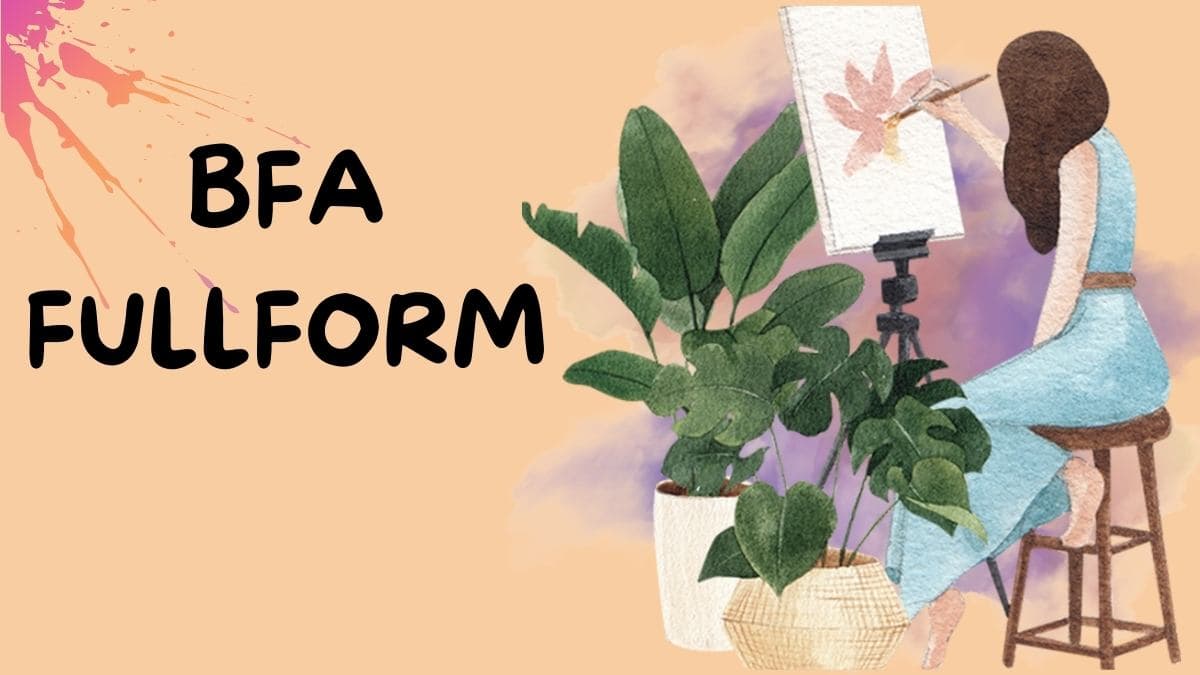BFA Full Form ( Bachelor of Fine Arts); History, Eligibility , Examinations & More Explained
By Pinkey Sharma |
Date 02-09-2024

Table of Contents
Admissions Open for
The BFA Full Form in education stands for Bachelor of Fine Arts, a degree that is somewhat esteemed and specialized in academics and also for students interested in visual, performing, and design arts. Recognition of the BFA in its full form will not be complete without understanding its in-depth meaning when talking about a career in art.
History of BFA
Having known the BFA Full Form (Bachelor of Fine Arts) in education, let us explore its history. The history of the BFA dates back to the early 20th century when art teaching was almost wholly non-formal. Artists gained their skills through apprenticeships, self-study, or private tuition. Formalized art education programs marked a significant shift in how art is taught and valued.
The concept of BFA Full form appeared when art colleges started to systematize the education of art and realized that comprehensive and structured training was required. Thus, the degree of Bachelor of Fine Arts was designed to be quite intensive, combining practical artistic training with theoretical input.
Until then, the BFA was considered synonymous with more orthodox art forms such as painting and sculpture. With changing times in the world of art, however, the BFA programs have come to encompass a wide array of disciplines, from digital media and graphic design to performance arts. This depicts the evolution of art and its requirement to be complemented by academic programs that reflect contemporary practice and technologies.
Eligibility Criteria to Attend BFA Examination
Certain eligibility criteria have been prescribed for the students who aspire to join the BFA degree course. If a student aspirant has some knowledge of the same, it will help in seeking admission to the course of BFA. The following are the usually recommended requirements:
Background and Qualification: The candidate needs to have passed the 12th standard or its equivalent level of schooling. This is usually the basic requirement for admission to any BFA course. Some institutions may require that candidates have studied certain subjects related to the arts during their high school years.
Artistic Ability: Most BFAs have an artistic ability that needs to be demonstrated. This is typically done by submitting a portfolio of work or by sitting for an admission test. The portfolio should encompass several artistic skills and demonstrate the candidate's promise.
Entrance Exams: Some institutions conduct entrance exams and test the applicant for creative and technical abilities. Such examinations also include practical tests, like drawing or painting exercises, besides written tests on knowledge about concepts and the history of art.
Interviews: Other than exams and portfolios, some BFA programs may have interviews as one of their admission procedures. Interviews will provide an opportunity for the candidates to discuss their artistic interests, career objectives, and motivations for pursuing the BFA degree.
Primary Purposes of BFA
The full form of BFA encompasses a set of primary objectives that are intended to enhance the learning experience of the students pursuing this course and have a successful career in the arts:
Skill Building in Arts: The BFA course aims to enhance the student's techno-artistic skills. For this purpose, practical training in the different forms of art will be provided, including drawing, painting, sculpture, and digital media. Students master techniques, learn to experiment with different mediums, and further refine their artistic skills.
Nurture Creativity: The BFA program encourages creativity and individual expression. It allows students to find their unique artistic voice and develop original work reflecting personal style. Exposures for experimentation and innovation facilitate the broadening of boundaries in creative practice.
Art History and Theory: Equally important in the BFA course is the knowledge of art history and theory on the part of students. Students will review the development of art, main movements, and prominent artists to develop an informed sense of the context in which they create their work. Such knowledge allows students to make more thoughtful decisions about their artistic practice and contributes to their general development as artists.
Professional Preparation: The BFA is a practical preparation degree focused on students who wish to pursue a professional career in the arts. Students will build a professional portfolio, and participate in internships or studio practices, as well as business classes in art in marketing, gallery management, and freelancing.
Critical Thinking and Analysis: The BFA course of study nurtures critical thinking and analytical processes. Students learn to critique their work and that of others through assessment critiques, reviews, and discussions the student gains a much broader insight into both artistic process and standard.
BFA Regional Offices
Fine arts are a rich tradition in India, and the BFA course structure makes it one of the most sought-after courses among students who are interested in any form of art. Many universities and institutes offer this course throughout the country and to facilitate the proper conduction of the course regional offices are established that handle the admission process, development of course structure and student support services.
Regional Offices: Role
Regional offices in India for the BFA programs have the responsibility to make sure that there is proper maintenance of standards and quality with regards to fine arts education. The regional offices monitor the academic processes such as admissions, examinations, and the final results. Additionally, the offices also connect with the Central University and the affiliated colleges to ensure that the curriculum is implemented in a uniform manner.
Student Support and Opportunities
For any assistance relating to the course, scholarships or career counseling, the BFA students can reach out to their respective regional offices. These offices also work with local art communities and the cultural organizations in order to introduce students to the art world, thereby enriching their knowledge and learning.
Location and Accessibility
The offices are located in Delhi, Mumbai, Kolkata, Chennai, and Bengaluru. The locations are spread in a way where the offices can easily be accessed by students from all parts of the country. In addition to handling the administrative affairs of the BFA courses, they also act as counseling centers for many students.
Regional offices of BFA in India are, therefore, important in the delivery of quality education and support that a student needs along his fine arts educational journey, cultivating his or her talents for successful careers.
Examinations Conducted by BFA
Examinations included under the BFA full form in education are meant to assess the skills, knowledge, and development of the students in the respective arts. These examinations are quite crucial since they determine whether the student has reached the required standard to be declared fit for graduation. A view of some of the examination types that are usually conducted is given below:
Studio Assignments: Studio assignments form the main body of the BFA course, which provides an opportunity for students to apply their knowledge in practical projects. The assignments could range from art-making and design projects to collaborative projects. Students will be evaluated on the creativity of the work, technique, and achievement of the objectives of the project.
Critiques and Reviews: These are an important component of the BFA course. Students shall have to present their work to the faculty and peers to get feedback and evaluation. The sessions shall help in refining the work and building critical perspectives leading to constructive debates on one's artistic practice.
Written Exams: The students are put through a series of written examinations that establish their knowledge of art history, theory, and criticism. This may also involve written tests of a multiple-choice nature with questions and short answers about various topics associated with the arts and context.
Final Projects: Many BFA programs culminate in a large final project or thesis. This will permit the student to demonstrate mastery and artistic growth. Students are usually required to present their final projects before a panel of faculty that reviews the work for criteria such as, but not limited to, originality, execution, and conceptual depth.
Portfolio Reviews: Throughout the program, a portfolio is developed that consists of the student's best work. Students' work that has been created is measured in terms of quality and range through portfolio reviews. For job applications and exhibitions after graduation, a well-curated portfolio is very important.
Conclusion
BFA is the short form of Bachelor of Fine Arts; it is an intensive as well as specialized education in the arts. It prepares students to acquire experience, skills, and knowledge that would help in furthering successful careers in these fields. Knowing the BFA full form by understanding it, students may decide about their future career prospects according to it. Moreover, the BFA degree provides a meaningful basis for a large number of professional careers in the arts as it extends the artistic capacity of the student and provides sufficient background for a student who wants to live a fulfilling creative life.
FAQs
1. Can the 12th pass apply for BFA?
Yes, the candidates passing their 12th class examination or its equivalent examination are eligible to apply to the BFA course. The basic qualification that allows a student to take up the full form of BFA is a high school diploma or its equivalent.
2. What is the qualification for a BFA?
B.F.A. stands for Bachelor of Fine Arts, which is a curriculum undergraduate level degree course under which students come across various art practices coupled with theoretical knowledge of the arts.
3. How many subjects are there in BFA?
The number included in the program of BFA varies according to institutions and their focus area. By and large, core subjects that make up the regular curriculum of BFA include drawing, painting, sculpture, art history, and theory. Besides these, there is always a possibility that the students take elective courses or specialize in certain subject areas where choices are available.
Liked the above blog? Then, please feel free to share it with your friends and spread the knowledge on “BFA Full Form in Education”
CBSE Schools In Popular Cities
- CBSE Schools in Bangalore
- CBSE Schools in Mumbai
- CBSE Schools in Pune
- CBSE Schools in Hyderabad
- CBSE Schools in Chennai
- CBSE Schools in Gurgaon
- CBSE Schools in Kolkata
- CBSE Schools in Indore
- CBSE Schools in Sonipat
- CBSE Schools in Delhi
- CBSE Schools in Rohtak
- CBSE Schools in Bhopal
- CBSE Schools in Aurangabad
- CBSE Schools in Jabalpur
- CBSE Schools in Jaipur
- CBSE Schools in Jodhpur
- CBSE Schools in Nagpur
- CBSE Schools in Ahmednagar
- CBSE School In Tumkur

Call Us to know more about Orchids
Swipe Up
















